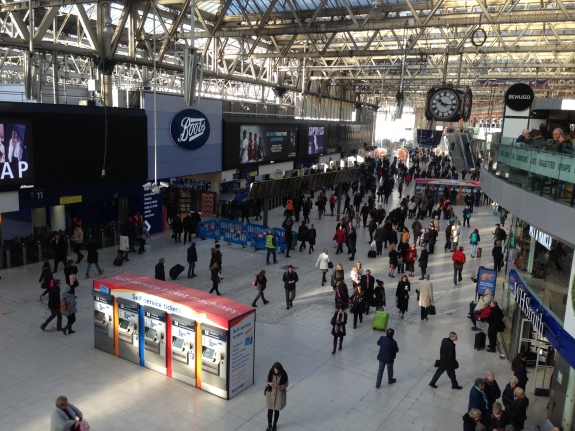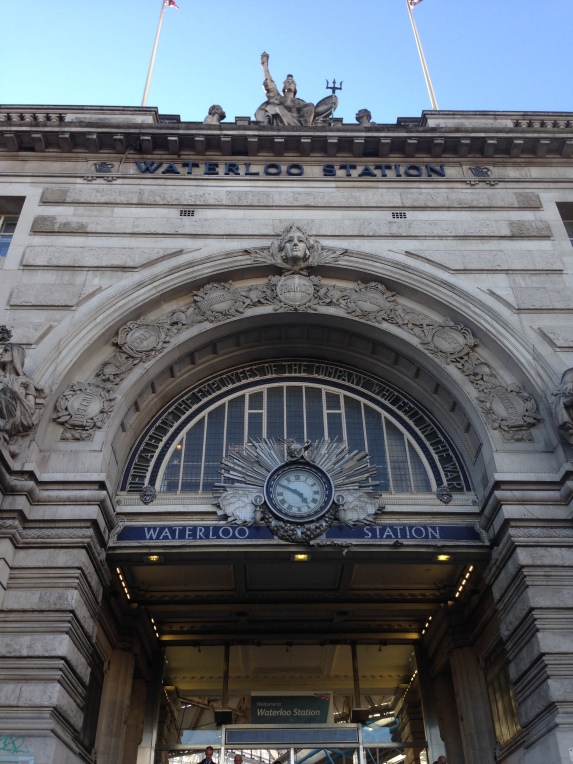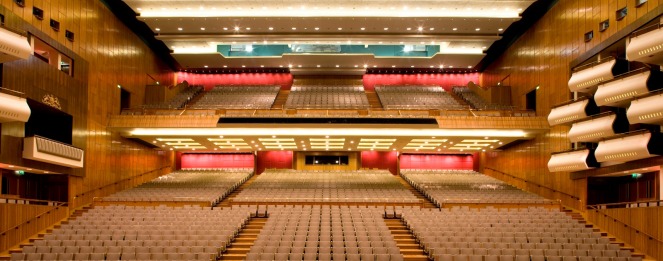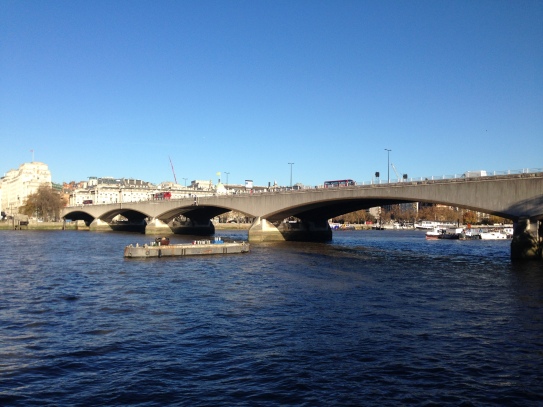It’s that time of the week again as I make another one of my trips around our great capital! This week’s journey starts at Waterloo Station and takes the short walk to a spectacular piece of architecture, as I end at The London Eye. My walk will take me via the Royal Festival Hall, and three bridges, Waterloo, Hungerford, and Golden Jubilee. So let’s get started!

Like all good walks, I need to begin somewhere, and today it’s Waterloo Station. This terminus is Britain’s busiest train station with over 88 million people using it every year, with a staggering 22 platforms! But wait. I hear you ask. Doesn’t Clapham Junction have a sign saying IT’S the busiest train station in Britain?! Well that’s true, this is measured by how many trains pass through it, but for the sheer volume of passengers, Waterloo takes the honour.

Waterloo Station was built in 1848 by London & South Western Railway as an extension of the mainline from Nine Elms Railway Station, which in the 1830s was a London Terminus.
Back in the 1850s to deal with the overcrowding problems of London’s cemeteries bodies were transported to a purpose-built Cemetery in Brookwood, Surrey from Waterloo. This gave it the name of the ‘Death Line’!
In 1878 and 1885 new platforms were built in the North and South of the station respectively. The terminus was rebuilt between 1900 and 1922 with it officially reopening in March 1922. It took nearly 100 years for the roof to be refurbished, happening between 2001 and 2003.

Until it was moved to St Pancras in 2007, the Eurostar service ran from Waterloo Station, which began in 1994. Interestingly, French passengers weren’t happy about arriving in London to a station which reminded them of the French’s defeat at the Battle of Waterloo. Incredibly, one French politician went so far as to write a letter to then Prime Minister Tony Blair to demand it changed its name! But to no avail!
The terminus today covers an area of 24.5 acres with the roof measuring 20ft x 540ft with a maximum single span of 118ft. In addition to mainline South West Trains, the underground station has the Bakerloo, Jubilee, Northern and Waterloo & City tube lines.

One of the entrances has what is known as the Victory Arch, which is Grade II listed. It was built from Portland Stone between 1907 and 1922 by James Robb Scott. It represents war and peace, with the Britannia figure over the top of it bearing the torch of liberty.
My walk from a busy station takes me past the Royal Festival Hall, a grade I listed hall which first opened in 1951.

It’s one of the world’s leading performance venues with a capacity of 2,500 seats with the London Philharmonic Orchestra, the Philharmonia Orchestra, and the Orchestra of the Age of Enlightenment being notable residents.

From the sound of music I take a slight detour to the sound of water, to my next destination along the Southbank, Waterloo Bridge!
Until the beginning of the 19th century, Blackfriars was the only bridge between Westminster and London Bridge. John Rennie was the engineering mastermind behind the first stone bridge which was laid on the 11th October 1811.

Originally called the Strand bridge, it was renamed Waterloo Bridge as a lasting legacy of the victory achieved in the Battle of Waterloo. It opened in 1817, on the second anniversary of the battle, at a total cost of £937,391.
By 1884 the foundations of the bridge were becoming exposed by the scour of the river, and as the years progressed it gradually got worse. In 1924 traffic was closed from it with a temporary bridge constructed. For almost a decade there was controversy as to what to do with the old bridge, and finally in 1934 it was decided to erect a modern bridge. The new bridge we see today fully opened in 1945 at a cost of around £1 million.

The demolition of the old bridge and the design and construction of the new one were undertaken by Messrs. Rendel, Palmer & Tritton in association with the Council’s Chief Engineer, Sir Peirson Frank. The collaborating architect was Sir Giles Gilbert Scott. The new bridge is constructed with reinforced Portland Stone and grey Cornish granite, which was cut from the old bridge. To this day it sits perfectly on the South Bank scenery!
I now go from one vintage bridge to another, Hungerford Bridge, and to a more modern-day structure, the Golden Jubilee Bridge! Designed by Sir Isambard K. Brunel, Hungerford Bridge opened on the 1st May 1845, with the area having formally been a wharf and timber yard.

However, in 1859 the Charing Cross Railway Act authorised the construction of a railway to cross the Thames near the site of Charing Cross Station with the suspension bridge removed. The new railway bridge began work 1860 and was completed in 1864 with a walkway either side.

By the 1990s a decision was made to replace the footbridge with a new structures either side of the Hungerford Railway Bridge. Lifschutz Davidson Sandilands and engineers WSP Group won the competition to design it in 1996, and the two new 4-metre (13 ft) footbridges were completed in 2002. The Golden Jubilee name is in honour of the fiftieth anniversary of Queen Elizabeth II’s accession to the throne.
My final stop on today’s walk takes me to perhaps the most famous wheel in the world, The London Eye! Designed by Marks Barfield Architects and opening in 2000, it’s the world’s largest cantilevered observation wheel standing at 135m high. Interestingly, the wheel only had planning permission in its current location for five years with a plan to move it to a new location. However, due to its popularity it remained, and has now become Britain’s most popular paid for visitor attraction, and a marvellous addition to the London skyline!
It takes 30 minutes to go around the London Eye with a view of 40 km in all directions! There are 32 capsules to represent the 32 London boroughs with each weighing as much as 1,052,631 pound coins. Although, there are 32, for superstitious reasons they are numbered 1-33, with 13 being left out, as this is seen as an unlucky number.

The London Eye can carry 800 people in each rotation, which is the same as 11 London red double decker buses. And don’t worry about the pace of the rotation… it goes at a speedy 26cm per second… twice as fast as a sprinting tortoise! One of the most notable events each year on it is the fireworks display on New Year’s Eve, and last year I was luckily enough to be there! Lasting just over 10 minutes, it’s a truly breathtaking spectacle, and a wonderful way to greet the New Year!

Well my walk has taken me from the busiest railway station in Britain to the most popular attraction in Britain via the bridges of the capital. Hope you enjoyed it, and please leave your comments and thoughts below! You can also catch me on Twitter and Instagram too, and don’t forget to sign up to my blog!
Until next time, see you later! 🙂
Sources: (not the food sauces)
All photos taken by London Wlogger, unless credit given. © Copyright 2016
History of London Waterloo – Railway Technology
9 Things You Didn’t Know about Waterloo – Londonist
History of the Victory Arch – London Remembers
Royal Festival Hall – The Southbank Centre
History of Waterloo Bridge – British History Online
History of Hungerford Bridge – British History Online
Golden Jubilee Bridges – London Town




I’ve seen some changes in all this since I first began commuting from Raynes Park in 1960
LikeLiked by 1 person
Haha yes, The London Eye and Golden Jubilee Bridge have been wonderful additions to the South Bank 😊
LikeLiked by 1 person
Makes me realize what I miss since not being able to go up to London every week for myself.
LikeLiked by 1 person
Hopefully my walks make you feel like you’re still there 😊
LikeLiked by 1 person
They do indeed, many thanks. I look forward to reading more. Take care and all the best for 2017.
LikeLiked by 1 person
Excellent, thank you! Have a wonderful New Year too 😊
LikeLiked by 1 person
What a delightful walk! I see images from the London Eye frequently. An American friend living in London always takes her visitors there.
LikeLiked by 1 person
Thanks Anne! 😊 It’s one of the most popular attractions for any Londoner or tourist to visit!
LikeLiked by 1 person
I hope your blog will still be online if I ever get to London! These are great walks and posts!
LikeLiked by 1 person
Don’t worry, Debbie, I’ve got lots of walks and exciting features planned! 😊
LikeLike
Back in 2007, we went to Paris on the Eurostar from Waterloo. On another day, arrived by Tube and walked from the Eye down the South Bank to the Tate Modern.
Thanks for prompting memories again. Have a great New Year and stay warm. It will be btwn 22-29 C this week in Florida again. A hot winter so far.
LikeLiked by 1 person
Awesome, thanks for sharing your memories 😊 Wow that’s warm, it’s a barmy 6 degrees here! 😜 Have a wonderful New Year too 😊🎉
LikeLiked by 1 person
Another great post. Yay. I now will look at Waterloo station with new eyes. Mind, I find myself mostly at Victoria and Liverpool Street Station…Waterloo, not so much.
Happy New Year! 😉
LikeLiked by 1 person
Awesome, your knowledge has been broadened 😉 Check out my other walks, I’ve passed through Victoria and Liverpool Street already haha 😊 Have a wonderful New Year too! 🎉
LikeLiked by 1 person
Indeed it has. I know will spread the very knowledge I learned. Ahh, I missed the Victoria and Liverpool Street walks….will be sure to check them out…and no doubt, will learn a thing or two!;)
LikeLiked by 1 person
Haha awesome hope you enjoy reading them 😊
LikeLiked by 1 person
Am sure I will….will let you know of course! 😉
LikeLiked by 1 person
Excellent thank you! 😊
LikeLiked by 1 person
Ah, the sneaky ways railway stations try to stay on the most popular list! I enjoyed going along with you on your walk and look forward to many more in the new year! Cheers!
LikeLiked by 1 person
Awesome, thank you very much 😊 Haha, they want the limelight too 😉
LikeLike
Lovely pictures and a wonderful blog. London is one of my dream destinations for a holiday, I’d love to see the Emirates Stadium (being a die hard Arsenal fan) and 221 B Baker Street some day..
Have a wonderful 2017 🙂
LikeLiked by 1 person
Thank you so much, Aks, glad you enjoyed it! Hopefully you can use my walks as a guide when you visit here 😊 Have a great 2017 too 😊
LikeLiked by 1 person
Oh! Absolutely! That’s an amazing idea!!
Thank you 🙂
LikeLiked by 1 person
Awesome, happy walking 😊
LikeLike
I wish I did make it to London often enough. You can never get tired of its vibrancy and history. My favourite thing on any day out in the city is to go on a walk with London Walks. Loved your post and btw thank you for the follow.
LikeLiked by 1 person
You’re so right, wherever you go there’s always something historical or amazing to see! That sounds like my perfect day! Thank you very much, enjoy all my walks 😊
LikeLike
This is one of my favourite routes in London. Your blog is nicely written, chatty and informative. I will think of it next time I walk along the South Bank. Thank you!
LikeLiked by 1 person
Aww thank you so much, Nick 😊 Awesome that sounds good, hope you enjoy all my other walks 😊
LikeLiked by 1 person
Good morning, I just want to thank you for stopping by and following my travel and photo blog. I’ve been travelling recently and am just now getting time to sit down and check out my latest follower’s blogs. I love the concept of a walker’s blog. Sounds like a great way to explore a wonderful city.
LikeLiked by 1 person
Amazing to meet a fellow traveller! If you ever come to London, hope these walks can provide a nice guide for you 😊
LikeLiked by 1 person
My son visited London a few weeks ago and he told me he enjoyed his stay. It is now on my list.
LikeLiked by 1 person
That’s cool, it’s such a wonderful city to visit, you’d love it! 😊
LikeLiked by 1 person
nice!
LikeLiked by 1 person
very nice !! felt like i was there again. Do check out my blog too.
LikeLiked by 1 person
Great to hear, thank you 😊
LikeLike
Wonderful blog concept – I love it! I love London – it is amazing! 😀
LikeLiked by 1 person
Thank you very much, hope you enjoy all my walks 😊
LikeLiked by 1 person
This is more or less my daily route to work, minus half a mile. Great blog and very inspiring, I definitely need to get out in my lunch breaks more often.
LikeLiked by 1 person
Perfect, you now know a little bit more of the background of the sights you see 😊 Hopefully you can do more of my walks soon!
LikeLiked by 1 person
A thoroughly enjoyable read with some great photos to back it up. Thanks for sharing
LikeLiked by 1 person
Thank you so much, hope you enjoy all my other walks 😊
LikeLiked by 1 person